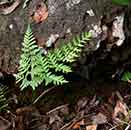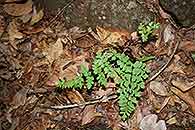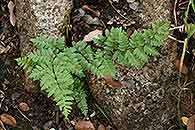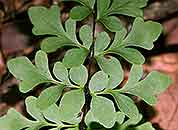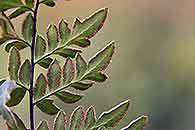Cheilanthes involuta (Sw.) Schelpe & N.C. Anthony var. obscura (N.C. Anthony) N.C. Anthony
Synonyms |
Cheilanthes involuta (Sw.) Baker var. obscura (N.C. Anthony) N.C. Anthony |
|---|---|
Common name |
|
Description |
Rhizome shortly creeping to ascending, c. 4 mm in diameter; rhizome scales linear-lanceolate in outline, apex gradually tapering to a point, margin entire, sometimes minutely toothed, 3–6 mm long, pale reddish brown, sometimes with a dark central stripe. Fronds monomorphic, tufted, 10-40 cm long, herbaceous to coriaceous. Stipe 2–15.5 cm long, purplish black, grooved, sulcus flat to square in cross-section, densely hairy and covered with brown or blackish scales up to 3 mm long. Lamina 2-pinnate to 3-pinnatifid, ovate to subdeltate or more triangular in outline with the basal pinnae the largest, usually basiscopically developed, 3–24 x 2.2–13 cm; pinnae 4–12 pairs; ultimate pinnules oblong, oblong-ovate or oblong hastate in outline, 10–20 x 6–12 mm, with crimped edges, upper surface glabrous, costules below with a few scales; veins free, obscure or ± visible; rhachis and secondary rhachises set with numerous or scattered lanceolate brown hair-like scales, grooved above, sulcus flat to square in cross-section. Sori linear, marginal; indusium continuous, suberose. |
Notes | May be confused with C. viridis var. glauca which differs in having a rhachis that is deeply grooved, an almost black stipe and veins that are clearly visible. Differs from C. involuta var. involuta by having a more triangular lamina, basal pinnae that are the largest and a sulcus that is flat to square in cross-section. |
Derivation | involuta: inrolled, referring to the sometimes inrolled pinnule margin; obscura: obscure, venation not being very visible. |
Habitat | Boulder bases and among rocks in woodland and grassland, stony places on lava hillsides, crevices in granite rocks. |
Distribution worldwide | African, Madagascar, Socotra. |
Distribution in Africa |
Angola, Botswana, Dem. Republic of Congo, Kenya, Lesotho, Mozambique, Namibia, South Africa, Tanzania , Uganda, Zambia, Zimbabwe. |
Growth form |
Lithophytic, terrestrial. |
Literature |
|
